The sickness behind modern creativity (it's not just influencers)
Confessions of a former Dream seller and story manipulator.
Hello. How broken do you feel today?
Remember a time when you didn’t feel that way? When scrolling on your phone felt like a window into the world, not a reflection warped to show everything you lack?
I remember when Instagram was less a marketplace and more of a way to stay in touch with friends. YouTube felt like a sacred space where strangers, their video quality sub-par, webcams angled too high, made breathy confessionals from their poorly lit bedrooms. It felt like sitting on the floor with a friend, like actual intimacy — without a sales pitch.
That simple comfort has mutated into something uglier. More grotesque.
The scroll now blurs into a parade of people shapeshifting from “just like you” to “subtly better than you” to “life guru selling you their reality-shifting protocol, cold plunge tub, and six-week blueprint to becoming less of a disappointment.”
We’ve hit critical mass on the mandate to “turn your passions into profit.” Everything sacred — every creative impulse, every version of the self, every morsel of truth — has been commodified, packaged, and sold to us. Then back to each other.
You try reclaiming your time, your mind, your sense of peace — only to find every escape route choked off by another ad, another product, another pitch.
If you’re wondering who profits from this…
Sometimes it’s me. The other me, Shadow Stephanie.
A former sales savant who once lived to monetize, and now built this product for people questioning what it all means. People like you.
Introducing the Brain Bomb™ Essay
Finally, a high-impact “solution” for your low-grade existential despair.
Inside this essay, you’ll discover:
✅ Confessions of a behind-the-scenes strategist: How she helped others turn desire into millions
✅ Why blaming influencers won’t save you — and might be part of the trap
✅ The 4-part framework that reveals the exact sales funnel we’re all already inside of (with no real escape)
✅ The simple reason sincerity sells better than strategy — and why things feel like a Black Mirror episode
✅ The one loss nobody talks about when everything becomes content (it’s so simple it’ll sound obvious once you hear it)
Join today for $4,997 $0
YES. For today only, get lifetime access to this long, slow, slightly unhinged essay…
🔥 Absolutely FREE. 🔥
You’ll learn about our founder, Shadow Stephanie, who built products and pitches like this, all engineered to pull sales. (But now she’s striving to build for a different reason.)
Skeptical? We thought so.
Cue these genuine, totally not made-up testimonials:
🗣️ “This essay made me rethink my role in the monetization economy. I built a media empire by doing less, and now I charge $20,000 to tell #girlbosses their brands won’t set them free.” — Anonymous
🗣️ “At first I thought this essay was broken — so many words yet no upfront thesis or takeaways, no ‘useful’ lesson. But I kept reading. Now I actually like it when I’m not told what to think or feel.” — @freelancew1zard420
Because guess what?
You’re already inside a Black Mirror episode.
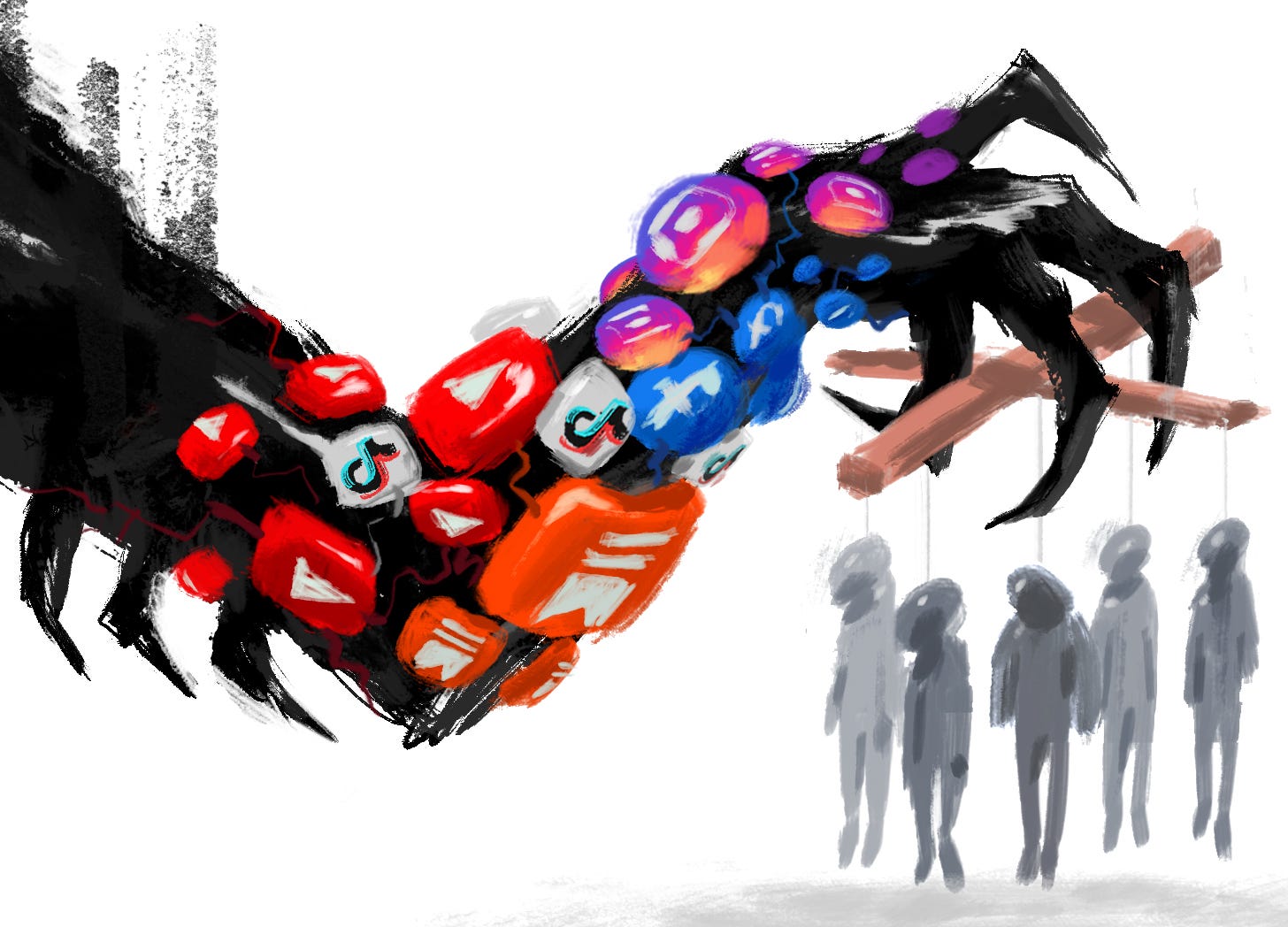
Hello again. Did you even blink at Shadow Stephanie’s fake pitch?
Probably not.
The logic of being sold to has been so deeply braided into our daily lives that none of it is even a surprise. We only feel that ache, that exhaustion, that sense of being relentlessly clobbered like some sort of cash pinata.
Because nothing is sacred anymore. Nothing just is.
Grief? Monetized. Hobbies? Already scaled. Joy? Repurposed into content.
Everyone plays their part. No one is untouched. Not doctors:
Not your favorite pet dog and hedgehog:
Not therapists. Not writers. Not even the people like me calling this stuff out.
No one.
All of us, trapped in the very machine we rail against but are forced to keep feeding.
If you complain, you get told: “Just get off the internet!” or “That’s just the way it is.” Simply bandaid-level reactions to a festering rot.
You tell yourself you’re immune. It doesn’t work on you, and maybe that’s true. The problem isn’t just that you’re being constantly sold to.
The problem is —
Why does knowing all that change nothing?
It’s not just the influencers, the course creators, the newsletter writers, the coaches, the YouTubers, and the podcasters. It’s also the artists, thinkers, and dissenters trying to resist, all of us using the same tools and internet speak. All of us playing on the same stage. People like…
Me.
Except now I’d like to believe I’m making for a different reason: Not for extraction but for the work itself. But even that can be its own kind of story, can’t it?
Maybe it’s penance, or maybe it’s the only way I know how to make art my way — while feeding the machine.
For years, I was its loyal disciple. It was liberating and seductive. I became proficient in selling, audience and pricing psychology, narrative control, product development — all the tools needed to help others build their 6-, 7-, and 8-figure empires. With them, I nurtured the machine — and in return, it gave me freedom: no commute since 2015, flexibility to do whatever I wanted, and money.
I told myself it was fine because I was growing, I was helping — and I was winning.
That eventually took its toll on me, being the one who was always supposed to “know” and perform that very knowing. I’d wake up realizing my strongest ideas had turned into slogans and headlines, repeated and repurposed. I started to wonder if I even believed in my own messages — or if I was just repeating them because they work, they sell.
Fast forward to now and I look at things very differently.
Where I once urgently crafted the advice, the soundbites, and the content that claimed to “fix” you and weaved the stories to tug on heartstrings, I now can’t hear any “new” methods or advice, even if good, without a reflexive recoil.
Because damn, I’m tired. We all are. This Reddit post says as much:
This struck the collective nerve. The comments are full of people echoing the same sentiment, clearly having been burned too many times, for too long.
It’s easy to rage at the individuals (and the people behind them like me) pushing the “not enoughness” on you while holding their own solutions behind their back. It’s easy to be bitter and paint them as the villains.
They're the ones making the posts!
They’re the ones mining our attention!
They're the ones monetizing pain and pitching the solution!
But having been on the other side, I can tell you that most of us have good intentions. We’re not bad people. Some of us actually DO have things worth saying and teaching.
The truth is, the selling starts from real insight. Something that changed our life. We look around and realize that what’s out there isn’t it, so we share our version. If it lands, we also start to see its impact and how it could actually change other people’s lives — and make money. Sometimes tons of it. That’s the most intoxicating kind of win-win.
But things go way deeper than that. Past the goodwill or the justifications.
If you zoom out, like way out, you start to notice…something else.
Something eerie in its sameness.
You start to see a monetization pattern that looks too consistent and too scripted, across industries, platforms, and personalities, to just be the result of individual actions.
And what you’re left with isn’t any one influencer or creator anymore, but what’s behind them: a web of invisible economic, cultural, and emotional forces. Each thread pulling tighter and tighter until the choice to monetize starts to feel less like gumption and more like something pre-decided.
This isn’t just about greed or ambition gone too far. This is about a system that thrives on keeping everyone stuck.
A confluence of squeezes with no clean way out.
Welcome to the double bind
Take a look at these recent headlines:
When an annual salary of $100,000, a milestone that once signaled middle class wealth and stability, isn’t even enough to live on in major cities…
When the soaring cost of living means choosing between paying for rent or groceries…
When the job(s) we do have both burn us out and underpay us…
…the urge to monetize online isn’t just about seduction or ambition.
It’s survival.
What choices are left when companies are constantly talking about cutting labor costs? When AI erases entire roles? When the old promises of “get a college degree” and “hard work pays off” start to sound like sarcasm?
…do I even need to say it?
Then there’s the other side to it.
We’ve always been a scrappy, resourceful bunch. We’ve always found a way to adapt and survive under any conditions. Some of us way better than others.
There is what appears to be a “loophole.” Look at these headlines:
When you juxtapose these against the economic collapse, the cultural story is saying:
Yes, things are bad, but look, THESE people are fine. Thriving, in fact. And you would be too, if you knew what they knew and did what they did.
The real reason you’re in this situation is because…
Your mindset is bad, you’re unmotivated, you make too many excuses, your discipline is weak. Do you even wake up at 5 a.m.? You’re not hungry enough. Be your own boss. Get out of the rat race. Hustle. Anyone can do it. You have a business inside of you. Grind. You have every tool available to make money while you sleep. Hustle-grind. Look, a homeless guy did it. Even that mommy blogger. You have no excuses. Hell, capybaras go viral every day. The only person holding you back is yourself. Sleep when you’re dead. Skills are cheap, passion is priceless.
HUSTLE!!!
The machine feeds on exactly this: A culture that keeps you squeezed, then tells you it’s your own damn fault and sells you the escape plan. That if you’re still stuck, still complaining, it’s not a problem with the system. It's your failure to rise above it.
And that’s the double bind.
If you sell, you’re complicit. If you don’t, you experience hardship AND you’re gaslit for not “doing everything you can.” Even opting out becomes its own kind of bind.
Damned if you do. Damned if you don’t.
Of course, I believe in personal accountability. Of course, I believe in working for what you want because no one is going to rescue you. But there’s a difference between personal responsibility and constantly being told any struggles are your fault, part of your brokenness — only to also be told the solution is soOoOoo simple:
Turn your hobbies, passions, and knowledge into an income stream!
In other words, pursue the Dream: of “passive” income; of freedom and flexibility; of monetizing exactly what makes you…you.
This is the era of Optimize Everything, where even truth and meaning have to pay rent. Where building a business is building the Self.
And monetization becomes both survival and service to this Dream.
That’s where I come in: As someone who once believed in this story and benefitted from it…
…and helped others tell it better.
Where brokenness is profitable
You know the headlines I showed you earlier?
I’ve also architected stories like these across different publications for different people and businesses. Stories that brought an additional $200,000 in revenue for one client; and landed an HBO crew on the doorstep of another.
Of course, these headlines are true. Freedom is possible. A lot of people really have made it. I’ve seen the dashboards that measure revenue, plus media outlets require tax documentation as proof.
I was never the face of any brand I worked with. Instead, my role was like a ghost, invisibly effective and surgical: I gave away my best ideas, I knew what stories got attention, I made the multimillion-dollar products, and I watched this belief, this Dream, take root in others. Some people got very, very rich. A lot got burned.
I used to think selling your soul made itself obvious.
Like you had to be doing something so truly cruel and malicious that you’d catch yourself before things went too far. But no one ever warns you how quietly and slowly moral decay can sneak up, how it smuggles itself into hundreds of small choices and actions, each one easy to justify in isolation. It doesn’t announce itself. It stacks and stacks and stacks until, finally, it’s revealed not because you caught it but because you don’t recognize yourself anymore.
When everyone’s taught to see themselves as a CEO, as greatness-in-the-making, as one hard effort away from freedom, everyone’s trying to hustle each other.
There’s no one left to just be a person, including myself.
That’s what burned me the most: The gradual erasure of who I was and what I wanted.
A lot of the people selling the passive income dream, as I once helped them do, frame this as empowerment: That not only can you monetize your joy or yourself, you should. That it’s not just possible, it’s your obligation — your goddamn right! — to take back control of your life, build a personal brand, and…
…dream biGgerrrrr.
And if you don’t Dream, you’re leaving money on the table. You’re forfeiting freedom.
I believed that once, too.
I want to be clear that the people I worked with weren’t villains. We all meant well and a lot of us truly helped a lot of people. And like many in this situation, I did what I knew, with the tools I had, inside a system that rewarded certain behaviors more than others. And after enough reps at various levels of success in the system, I started to notice a clear, repeatable pattern.
A self-fed pattern that reveals just how deep the illusion of choice and freedom goes.
If I were still a product-making guru, I might even call it…a flywheel.
Actually, I think I will.
Let me walk you through my patented, proven, industry-recognized —
This flywheel mirrors many course frameworks for growth, but here I am using it to explain how the Dream is injected straight into the cultural and personal bloodstream — and exactly how it metastasizes into a sickness.
Step 1. Paint the Dream
Most people don’t dream of running a business. They don’t automatically have the chutzpah or thought to even start one. That was me at one point. I never thought I’d be an entrepreneur, let alone help sell this Dream.
I was a writer at heart. I wanted to write cool things.
Like most people, what I wanted — really wanted — was to not feel trapped, to not dread Mondays or write another damn “Thanks Jenny, let’s circle back and touch base later!” corporate email.
Most people just want to not feel like suckers because life is wringing them dry.
Good, ethical marketing and copywriting know this already. They name the previously unspoken, stir up emotions, and move us toward something real. Like so:
Picture this: It’s Sunday evening. You’re on the couch, snacks in hand, about to watch your favorite show. No report hanging over your head. No 9 a.m. meeting in sight. Instead of that usual knot in your stomach, you feel…light.
Then — bzzzt!
It’s not a boss pinging you — whew — just an email notification from your own business. You tap: Another $800 in your bank account… while you were kicking back. On a Sunday. Automatically.
It still feels surreal. Just a year ago, your Sundays looked different: You’d stare at the clock, anxiously calculating how much “freedom” was left. That creeping dread growing as the remaining hours of your weekend slipped away. A ritual of mentally bracing yourself for another five days of pretending you were fine — just make it to Friday, you’d tell yourself. And that was life.
But now? You look forward to Mondays. Another week of taking on projects that energize you instead of drain you.
Because now? You’re the boss. You set the terms. You’re in control.
That’s the gist, crafted originally to show as a quick example here. Notice the subtext: Look at how much agency you lost. Your life doesn’t have to be this way. You can take back control.
Nothing you haven’t heard before by this point, sure, but here’s the thing: Effective copywriting taps into raw desire in great specificity, not just vague entrepreneurial fantasy. No one ever became a believer by only being told “you’re broken.” It says “you know this feeling of relief.” Here’s a real example in the wild:
Then there’s the other thing: The marketing may not change your mind immediately. It works slowly, like seeds for belief setting their roots.
Because once something is repeated or seen enough (through posts like the above, headlines, and testimonials), you start to believe it. Like I did. And so it began.
I didn’t just tell these stories. I designed how they would echo and refract through pockets of culture. And I did it well — sometimes too well.

Over time, even if reluctantly, it takes up brain space and sticks. And maybe, just maybe, it becomes the solution you reach for when the next pitch comes around.
That’s the beauty — and the magic.
Step 2. Make lots and lots of content
This is where the hustle gets its oxygen.
The logic goes: Since there’s so much content and so much noise, the only way through is to flood the system. Outdo the noise with more hooks, more urgency, more output. Slice the podcast — hell, turn it into both a full video and clips. Repurpose the repurposed. But also never forget:
Be authentic. Be yourself.
Inundate every channel like your success depends on it. Because actually it does, according to the algorithm (and certain gurus).
It’s easy to forget that influencers didn’t come out of nowhere. There were folks like Oprah and Dr. Phil, who are still around today. Platforms just made visibility more scalable and accessible. And when the algorithms showed up in full force in the mid-2010s, it wasn’t about what you knew anymore, but how clickable you were. The face became the brand, and you became the product.
Sure, you should pay attention to thumbnails, headlines, positioning, narrative structure, SEO keywords, and whatnot, but those matter less until you have an extremely clear strategy. And for some, sheer volume is the strategy.
Most content and even books today are not built to be consumed. The goal isn’t connection. It’s capture.
Every essay, every video, every Note dripping in honey is, more often than not, designed to convert you into a follower, subscriber, and eventually a buyer.
Be generous. Overwhelm with value.
That was the play, and I followed it, telling myself that as long as things were well-crafted and beyond useful I was building goodwill. But I had ulterior motives. My generous content was strategic: Every lesson, insight, or fun story was specifically designed to “nurture” (actual insider term for engineering trust) until you became a customer. I wanted what my knowledge or outcomes were worth — in money.
And it worked.
Substack Notes like this still reinforce that very playbook:

Platforms reward that, especially if you’re consistent. They value the individual because we no longer trust faceless institutions. They favor relatable emotion because it works — it converts — and then they amplify what performs.
That’s what becomes legible. That’s what gets distributed.
So anyone trying to make a living online adapts to these rules, usually by becoming a personal brand. We often have to warp our work to be as “sincere” as possible, but really, it’s a rung in the ladder, leading people toward a means to an end: parasocial intimacy, a sponsorship deal, or a revenue stream.
That’s what makes this feel so wicked: Even generosity and sincere connection become bait and an extractive strategy.
And so we find ourselves straddling this contradictory line of not wanting to treat people only like they’re cash pinatas to break open…
But we’re also the ones holding the stick.
Step 3. Dream, copy, paste
Once anyone dives headfirst into the Dream, very quickly they run into more questions and the need for more tools, more knowledge, more ways to do it bigger, better, and faster.
How do you grow your following? On social media? On Substack? On YouTube? With SEO?
How do you package your insights into premium offers?
How do you build the “CEO mindset”?
For those selling the Dream of passive income or starting an online business, that means even more ways to make money. Which, of course, means graphics like this:
And then, inevitably, this:
All fuel for the Dream to rage on.
But the problem isn’t with one person selling this Dream and the endless infrastructure needed to uphold it.
It’s when everyone else does, regardless of their intentions, and their credentials and track record start to get a little…questionable.
Take this person, for example:
Okay, so let me get this pitch straight.
The ask is to follow them — so THEY could reach 100 subscribers.
Because their whole premise is teaching you how to GROW and SCALE a personal brand.
Even though their own personal brand only grows IF people follow them for that very advice…?
??????????
Oh.
There’s more.
If, perhaps out of curiosity, you do follow and click on their post to learn more about how to grow your Substack following, you’re met with:
A PAYWALL.
Cue 7 laughing emojis.
I wish I could say I was making this shit up.
Sharing real expertise is not a problem in itself. There are people teaching this stuff who genuinely have a lot of rock-solid insight and experience. But inevitably, there are also people like in the example above who learn just enough to sound credible, then try to pass off their paper-thin tactics as expertise. And sometimes, they cause more harm because they might encourage unethical practices and maybe even straight-up fleece people. Scammers, in other words.
I’ve traced this pattern across many industries, re-oriented in different ways, but it’s unmistakable: A transaction sometimes built solely on smoke and mirrors. And nothing more.
Sometimes I catch myself laughing not because it’s funny (okay, it kind of is), but because the cycle is so precise, so callous. The machine sustains itself through the propagation of believers, each carrying the Dream forward, each using the exact same frameworks and tactics to seal it. Some, again, way less ethically than others.
That’s how the sickness spreads, slowly at first then suddenly —
All at once.
Obviously, not everyone monetizing is bullshit.
I’ve worked with very smart, successful entrepreneurs, and I owe a lot of what I now know to our working relationships. But that’s the thing: When everyone is performing competence, it’s hard to tell the good ones apart from the hucksters for sure.
Because worse than someone who isn’t successful trying to pretend they’re successful so they could sell you their blueprint for success are the ones who are successful on the surface, but in their personal lives or business, they can’t and don’t practice what they preach.
They’re not exactly charlatans. Just walking contradictions. People who know better, but can’t always hold it together. People who sound all-knowing, but can’t help themselves in the arena they’re supposed to help you in. (Something I explored in my 58-minute video essay with Frasier below.)
Some examples of what I mean:
The business coach who helps entrepreneurs find purpose in their lives, but is lost and aimless in their own.
The mindset coach who pushes people to stop worshipping money, but chases get-rich schemes themselves.
The richest, most successful ones who help people do X, but know that, somewhere deep-down, their very business model depends on stuck people — and people staying that way.
That’s where I sold a piece of my soul, when I turned a blind eye to contradictions like these. Because they’re human.
And so am I.
And so, this is where we’ve landed:
A machine where hope is fuel and belief multiplies belief, until no one remembers who wrote the original script, only that it must be enacted.
On everyone.
Step 4. Freedom, but bigger
Biggie was right: Mo’ money, mo’ problems.
Because the Dream of freedom doesn’t start or end with just having the business. Even if it’s successful.
Nope.
You see, the most perverse version of the Dream, at the higher levels, is this idea that it’s not enough to simply make good money. Five figures? Cute. Six figures? Barely impressive.
The real flex isn’t earning more. It’s scaling more. Systemize it. Automate it. Delegate that shit.
That’s the unspoken pact: You must scale and systematize. It’s stupid not to. Go bigger, better, faster. Are you an entrepreneur or not?!
HUSTLE!
Oh, wait — my bad, I got my messages mixed up.
I meant: DO NOT HUSTLE.
The real question: How little do you work?
If anyone is working the standard 40 hours or more to make 6 or 7 figures, I’m sorry to say that’s chump status. You need an Effortless Business:
Make more. Do less.
In other words, make as much money as humanly possible, while working as little as possible.
That’s the new measuring stick for success in the digital age.
I get it. That is exactly why people started this in the first place: To escape traditional work and the hours that felt so suffocating. To do more (er, less?). To dream bigger.
However, scale is what the machine loves the most. It feasts on a steady diet of likes, views, and clicks. And we feed it because a mouth has to eat. Conveniently, so does ours.
This cycle — one that has led a lot of people to complete and total burnout — is made palatable by the most toxic seduction: That you can be “free” once you get to a certain point in your business. That since YOU’RE the boss the business can run on its own and generate immense amounts of money while you vacation and eat a lot of cheese in Italy.
HELLO, FREED$M$
For the extremely determined lucky few, that could be true. But for most, scale is an insatiable monster.
What often starts as a small operation can grow into something that swallows you whole because of ad spend, people, and expectations. The bigger your business, the more new problems come up, the more money you spend, the more new subscribers you need to sell to, the more dependent you become on platforms, the more you flood the machine to sustain it.
As a result, we all get hit with the ads. The headlines. The reels. The videos. The podcast interviews. The clips of those same podcast interviews. Endlessly, with ever-growing velocity from every single person sustaining the Dream, clawing at our crumbling attention. The problems only growing bigger, louder, more desperate until…
I think of a conversation I had with a friend who had grown her nutrition education business to millions in annual revenue. For nearly a decade, she tried to retire, but the business always found a way to drag her back in. Because when you’re the brand, you don’t just get to stop. You’re the one the machine wants. You’re the one that’s monetizable.
Eventually, she made a decision that startled me:
A quarter of a million dollars, not to invest or grow — but to scale down and escape. To stop outsourcing her life in the name of freedom.
I’ve never forgotten it.
Unlike my friend, most people at this stage don’t leave, even if they feel trapped. Most double-down or pivot sideways into an adjacent niche — or even turn around and sell the Dream themselves, if they’re not already. New niche, same game. Flood the system.
I’ve seen this exact pattern repeated over and over again with industry peers, friends, friends of friends, clients, even myself. It’s not if but when you’ll get consumed by the pressure to scale. The Dream is simply impossible to resist.
For me, I started my business because I wanted the freedom to write for no one else but myself, while being comfortably flush with cash. Dream bigger?
No, I wanted it all.
I had built my business to a level most would be thrilled with, but it was never enough. Build a bigger team, bigger client list, bigger everything — outsource it!
And I did so reluctantly, thinking scale would finally deliver on the promise that was supposed to have already arrived: my complete freedom, fully funded. Fully mine. Thinking that if I kept going, freedom was just around the corner, after one more 6-figure contract, just one more hire or process…then I can truly step away and let the business run while I focused on writing.
That’s what’s happening for people in the Big Leagues, right?
Right???
I remember speaking to another business owner who had scaled to $4 million per year with a similar business, and I asked them what their problems looked like. Selfishly, I wanted to hear that they’d cracked the code, that they were finally free to do whatever they wanted. But what I’d heard instead made me scream internally:
Same problems, different scale.
They were still not free.
That was when I knew, even if I busted my hump to scale bigger and bigger, who knows if I would ever get back to what I wanted? Was I ever going to “stop”? That was the bind.
Turns out, the business that was supposed to set me free becomes a different kind of cage.
Even Tim Ferriss, 5X New York Times best-seller with millions of podcast downloads, has described his own success as such:
“You start by feeding the machine through the cage, only to wake up one day and realize that you’re the one inside the cage.”
Many of my peers happen to love business for business’s sake: build, scale, get acquired, repeat — all of it fun, exciting problems to be solved. “It’s the journey!" everyone would say. Yeah, I’ve done a 10-year fitness transformation. I know all about the slog that no one sees. I had fun too (at times), and I don’t regret any single lesson. But the business was a means to an end for me, which, as it turns out, was this all along: doing what I’m doing now.
This was never about scale. It was about chasing a promise of arrival that never arrives.
Because even arrival isn’t enough.
“It’s simple,” they said, “You just need…the right mindset, tools, habits, hires, systems — all of which I sell, btw — then you’ll be free.”
Biggest grift of our generation, indeed.
Then there’s us
The audience.
We play our part too. We say we want truth and depth, but what do we actually engage with?
The emotional bait. The headlines with outrageous promises, like this:
The Substack Notes posturing as “let’s support each other’s journey!” when really, they’re an age-old growth tactic called follow-for-follow under the guise of community. And yeah, it works freakishly well for visibility and engagement:
In other words, we say we want something real, but we reward the instant dopamine, the fast punchlines, and the performances.
It’s hypocrisy, yes, but I don’t think it’s that simple.
I think a lot of us scroll for relief. Meaning. Maybe a glimmer of hope when everything feels fucked. When we’re burnt out, lonely, or craving connection, fast dopamine starts to feel like a salve.
But that’s also exactly what makes this so twisted: The very thing we reach for is what keeps the creator-audience loop spinning.
Creators know what performs through their analytics, often bending their work and their voice to meet better numbers. I’ve positioned stories and posts to bait the metrics I now claim to reject, and if you’re creating, I’m sure you have too. It’s the price of visibility, after all. The platforms in turn respond to what we’re clicking on and what’s being engaged with the most.
That’s how it decides what’s worth seeing.
The loop teaches creators what to make. So they keep making what works, and what works is often familiarity and sameness. Same headline formulas. Same hooks and story arcs.
Even the big legacy players aren’t exempt.
Once something is proven, it’ll keep getting made. Because if people clicked once, they’ll likely click again.
The algorithm teaches, the audience confirms.
Snake eats tail.
Can’t argue with this logic when the stuff performs.
Even the ones who do want to make something different and more meaningful to them learn the hard way: To continue keeping their Dream alive, to avoid being invisible and forgotten, the audience…must approve.
It’s why “realness” itself has become performative. And why it’s easy to forget what it felt like to make (or find) something sacred.
It’s just how the machine works.
It makes all of us complicit, even when you know it’s rigged.
Uh-oh!
Shadow Stephanie here. Looks like you are only reading the free version of this essay.
To unlock the rest of it, upgrade now to signal versus self: Elevated™
Oh wait…
I got ahead of myself.
I regret to inform you we’re still in the machine
So this is where we’ve ended up.
Everyday people getting squeezed from every direction — platform dynamics, a crumbling economy, and the self-replicating engine of the Dream itself. In summary:
The Dream says: Freedom is possible, if you monetize yourself.
You make endless content to grow.
You feed the Dream and the machine in order to stay relevant.
You’re encouraged to keep upgrading the Self to go bigger, faster, better.
The cycle repeats — belief begetting belief, performance begetting performance — until good intentions blur, and barely anyone remembers where the line was.
And here we are.
Our monetization culture can’t be reduced to a simple binary. It’s not “all creators are bad and greedy and trying to make money off us.”
It’s a full-stack of forces with the candle being burned on both ends: creators burning out (themselves or their team) trying to keep pace with shifting platforms and culture, and the audience feeling a soul-deep exhaustion from all the content and the pitches. Where opting out completely is not the most sustainable nor a tidy solution.
Maybe you think, after all this, that I am now anti-business and anti-monetization. I’m not. There’s nothing wrong with believing in yourself and selling. I believe good work deserves money, but that’s not what’s happening here.
What we’re seeing isn’t about fair exchange or value. Instead, it’s a system that turns everything sacred into strategy, everything meaningful into bait. It doesn’t care about sincerity. It only cares about what spreads.
What does bait look like exactly?
Bait often doesn’t look like bait at first. It’s encoded in plain emotional language, the kind that sounds sincere, urgent even. But once you hear what they’re really saying, you can’t unhear it. An example:
Translation: “Look at how easily I cracked the algorithm. Are you still busting your ass for NO results? Lol. Stop making totally avoidable mistakes and learn from me.”
That was probably an easy one, so here’s another that’s a cousin of those “let’s support each other!” Notes:
Translation: “I know it’s hard so here’s a relatable backstory, a clear before/after, and a call-to-action for engagement disguised as support. Because liking and commenting help ME, and you’ll feel like you’re being seen in the process.”
Support resonates particularly strongly on Substack because it’s marketed as one of the internet’s last bastions of community-powered work. It’s why we see so much community-coded language here (some sincere) versus other platforms — and why it also becomes the bait.
Last one:
Translation: “I’ve created a fictional but believable enemy. Please validate how noble I am as I exaggerate the performance, right now, on the stage I claim to resist.”
This one is particularly fascinating because it’s not clear how this person actually knows people are self-censoring. But it conjures up a familiar enemy — cowardice, conformity, and submission — and beats on a war drum for everyone to rise up.
And the kicker: It’s posted on a platform built to reward exactly this kind of algorithmic gasoline. This is what I meant earlier when I said even the critics who perform dissent in the exact way the machine likes aren’t untouched.
2,700 Likes. 126 Comments. 548 Restacks.
Proof enough.
Obviously, I’m not clean here. I’m on Substack writing about this. I’ve shaped stories and deployed language knowing full well how it bends perception, and why. That’s why I can’t unsee the deeper translations.
Once you’ve crafted enough yourself and seen enough variations from enough people, for long enough, the scent of bait is unmistakably there. All of it is just code-switching for the internet we are all a part of.
I’m not raging against the machine because it failed me. It didn’t. I’m haunted by how well it works — and how easy it is to fall in line.
If THIS ends up spreading somehow, fine. I wrote this because I had something to say, and it’s this:
There has to be a line somewhere.
This relentless push to perform and monetize parts of us — what we love, who we are, what we know, what we’ve experienced — is costing us more than we realize.
Specifically: It’s made us forget how to value something that doesn’t make us money, grow our audience, or prove our worth. If we can’t play without being productive, be curious without calculating ROI, or crave connection without assessing “usefulness” of the relationship, what exactly are we left with?
Perhaps this well-worn but highly appropriate maxim in this context:
This is why we can’t have nice things.
Because everything nice becomes commodified, if it hasn’t been already.
Nothing can simply exist for its own sake — a leisure activity, a way of living, a moment, a relationship — without immediately needing to prove its value, share it for attention, and then ask how it scales.
When nothing is sacred anymore, you forget how to recognize what should be.
I’ve wrestled with this plenty of times. It’s partly why it took me 10 years to come back to creating for myself. I’d discover a little spark of joy in something — film photography, sewing, maybe an insightful conversation — and immediately my mind goes to: But how can I make money off this? Then I’d run the quick calculations and decide it’s not even worth spending time on.
Even rest and leisure have to be justified (something I explored in my essay about decoupling from my productivity addiction).
That’s the damage and the sickness.
I still believe in empowerment, but I no longer believe in the kind that confuses proof of worth with actual value.
I miss the feeling that something mattered before it could be measured.
Because now the thing can no longer just be enjoyed. The most sacred parts of ourselves aren't for self-expression, but repurposed for some sort of hook, even if it starts with noble intentions.
That’s the tension of the double bind.
The urge to bend, just a little bit, to have our cake and eat it too.
The stories we tell ourselves, until they stop working
I played the game with its usual playbooks. I wanted my time, freedom, and enough money — and I got ‘em. In many ways, I achieved the Dream. But at what cost?
At the highest levels of the game, I believed that reducing people to metrics like subscriber count, average order value, and revenue was not only okay, but necessary. Each number was a proxy for a person I never had to see.
Human attention and engagement, reduced to predictable levers and cold math.
I think of Joan Didion’s line: “We tell ourselves stories in order to live.” Maybe we tell ourselves that we have no choice to monetize because how else are we going to make money? That we’re the only ones being real and everyone else is fake. Or that once we make a certain amount of money, then we’ll be happy, then we’ll stop.
We need these stories to keep going.
I was telling myself that I was building something meaningful, that I wasn’t even in the same galaxy as those smarmy grifters, that I needed more money and then some more — for what? I wasn’t too sure — to keep going exactly as I was. If I wasn’t hurting anyone, if I wasn’t lying, it felt kosher. It felt justified. I see now that I was living inside a story that had been packaged by someone else and sold to me too. What did I tell ya?
The Dream feeds on itself to stay alive.
But that story usually came at a cost — and it wasn’t always mine to pay.
Eventually, the story stopped working.
Eventually, I’d get a client win, but feel no pride. I’d show up every day, but feel like a ghost in my own work. I’d see my bank account number shoot up, but instead of joy there was only…emptiness.
Emptiness is a strange feeling. It shows up when it shouldn’t. I was the most successful I had ever been. I was respected by peers and loved ones. Wasn’t that enough? Shouldn’t I be happy? Why wouldn’t this weight in my chest go away?
It didn’t feel like a crisis. It felt more like forgetting in slow motion — of what I once believed and who I was.
Emptiness, it turns out, isn’t the absence of emotions. It’s the burial of all of them at once: the contradictory emotions, the flashes of both pride and shame, the flickers of satisfaction and disgust. All of it congeals into something heavy and unnameable. It’s the result of buying into a Dream that was never yours to begin with, and enacting it because it was part of the script regardless. Your whole existence becoming an echo of the collective voice, one that coos:
“Buy a house.”
“Build a business that pays you while you sleep.”
“Want more and be more than you are because it would be a travesty to just be...”
I didn’t know that then. I just knew I was unhappy. And I couldn’t sleep. Night after night, for years, I was wrecked by insomnia. The anxiety, this gnawing sense that nothing I did was ever enough, was constant.
I can’t remember the exact turning point, but there was one. There always is.
Maybe it was because I realized I had turned into someone I didn’t like. Someone who would brag about revenue, always scheming to squeeze more and more. Someone who would measure the value of others by their revenue numbers.
Maybe it was watching and reading stuff online, only to instantly recognize the attention-grabbing gimmicks, the pandering, the bait, the voice that sounded too authentic and sanitized — all of it objectively fine but all of it things I can no longer stomach when I was the one they were being used on.
Or maybe I’d like to think that one day I just wised up, stopped suppressing the emptiness, and examined it more closely.
Whatever it was, the dam broke.
And somehow I recognized it, finally.
Guilt.
Ah, you slippery bastard.
Once I named it, it hit me all at once: Guilt for shaping and amplifying stories I didn’t believe in. Guilt for how I could feel something was off sometimes and still push through. Guilt for betraying myself and for how long I’d been doing it.
That was supposed to be the cue to stop.
But instead, it was a seed. It would still take another year or so for me to walk away and start over.
I’ve told this story before in fragments.
But not like this.
I had to tell a new one.
Let me begin again
signal versus self is what came next.
If you’re here, there’s probably these big, honkin’ questions in your mind:
If I’m in the machine, writing things like this, am I not still playing the game? Is Shadow Stephanie not going to do her thing and monetize too?
Well. No one enters or gets out of the machine clean.
When nothing is sacred anymore, it’s hard to know what should still be.
But I do know.
Not just from recognition, but from contrast. From deliberately rejecting performance and optimization culture and the metrics that hijack meaning. The very ones I used to worship.
Both this newsletter and my YouTube channel are my attempt to restore that sanctity. It’s part creative un-optimization, part public rebuild of a new belief system.
This means I wouldn’t be trying to convince you I’ll change your life. I wouldn’t be trying to teach anything through didactic performance and frameworks as I once did.
I wouldn’t even be trying to build a brand like I once taught others to do.
I wracked my brain over every possible alternative.
Except refusal.
What if I just make cool work?
In a machine that deforms meaning into monetizable signals, making work on my terms becomes an act of reclamation — of the self and my voice.
Because I believe the most meaningful ideas shouldn’t be rushed, crammed into neat little lessons, or molded into Restackable elegance. They take time to build, to spiral, and to land — just like real thought does. This is exactly what the machine tries to convince people they don’t want. Because otherwise it couldn’t farm them as a brand, clip them into spreadable content, nor feed them back into the ouroboros monetization loop.
But people do want it:
As for monetization, I’m not against it. Monetization is inevitable. It’s not a question of will I? But a question of how?
I spent the entire essay circling the methods I’ve used to monetize before, and now when I do it, I have to be mindful of the paths that would erode my voice and creative longevity. After everything I’ve learned, how I do it has to serve something more than the machine, or I’m just shoveling my own words back into its mouth.
I recognize that if I don’t play nice by the current rules, it’s much harder to thrive. But if I do…?
The slope is always slippery, isn’t it? “Just this once…” becomes “just one more.” And once I bend, the work is no longer mine, but the machine’s. I’ve already spent far too long mistaking its voice for the sound of my own.
Turns out I have a choice, after all.
I still want attention. I still want to grow inside the machine. But I’ve seen and lived the spiritual decay of doing it any other way. Now, I only want to thrive if the work is wholly mine — about things I like, things that matter to me, in the exact way I want to make it.
Even if it’s strange.
Because strange is what refusal looks like now. Even when there’s no guarantee it’ll lead anywhere.
I could’ve waited to publish this until I gained a bigger audience, made more money. But then it’d be convenient, not conviction, wouldn’t it? This, too, is the double bind.
And I refuse to pretend otherwise.
My way isn’t “better.” It’s just the way I now know, after spending decades inside nearly every corner of today’s creative culture, how to return to something closer to art, for its own sake — without getting sucked back into the churn or betraying myself again.
It’s as simple as that, and that is everything.
When I offer something for sale, you’ll know. It’s the work itself.
The work IS the point.
If you see it too, I trust you to decide from there.
And me, I’m just learning how to make work honestly and stay creatively human in the machine.
That’s the story.
And I’m the one writing it for myself.














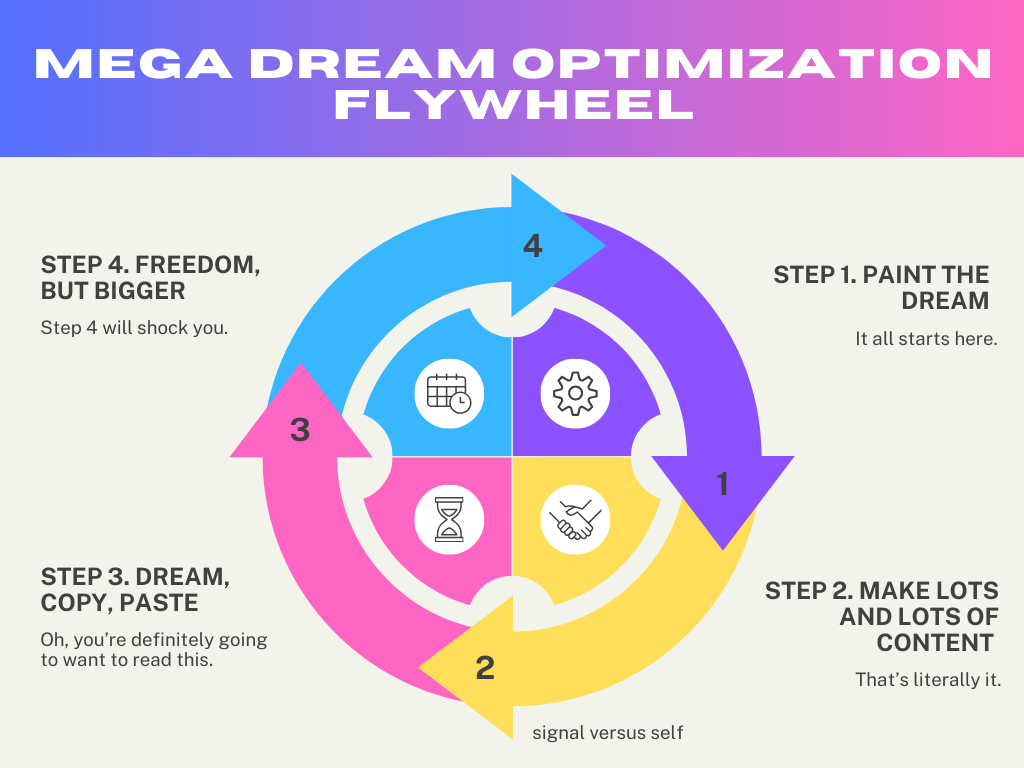
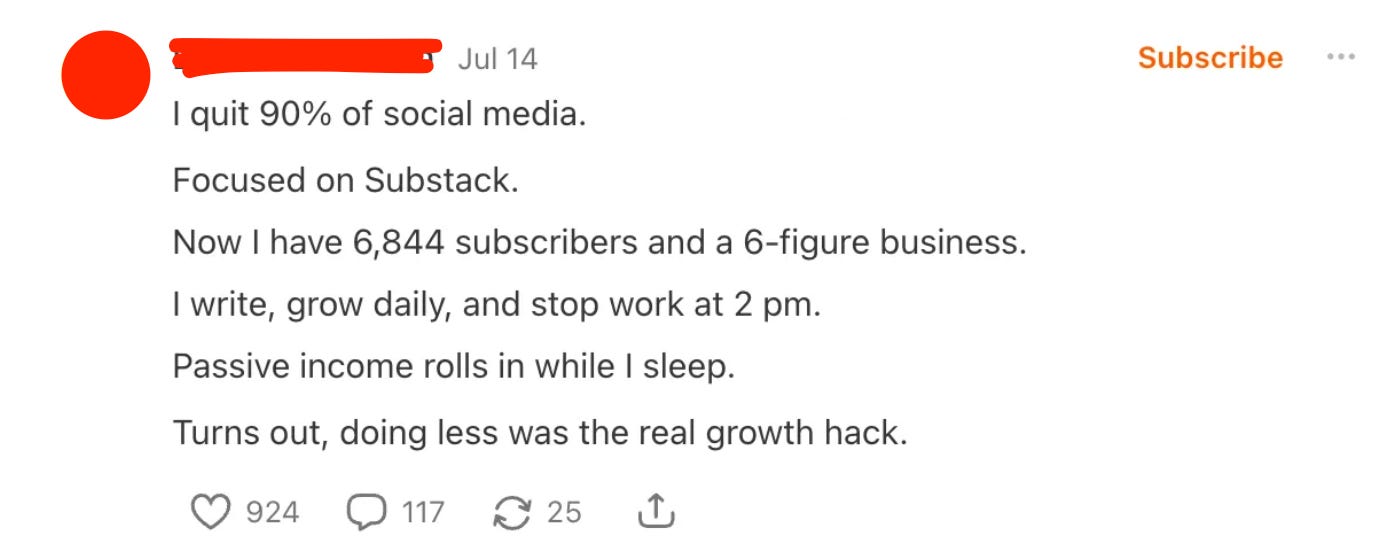




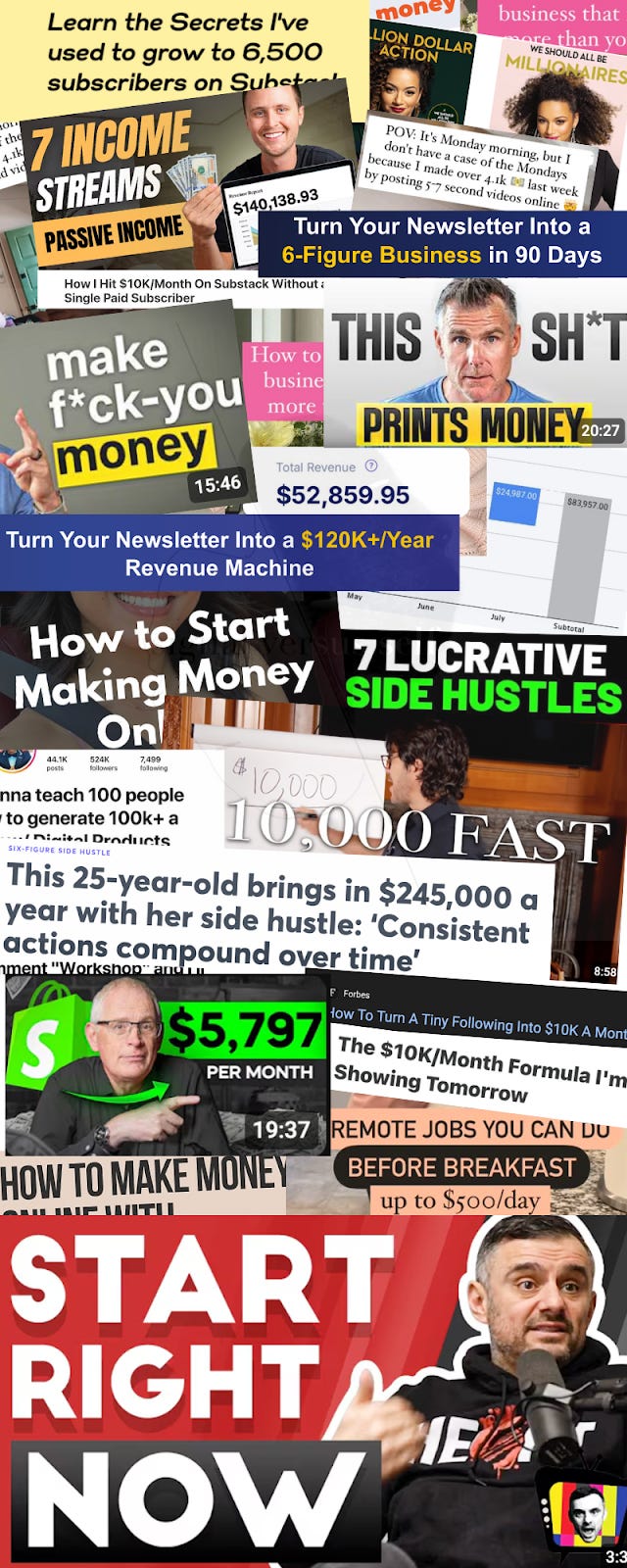



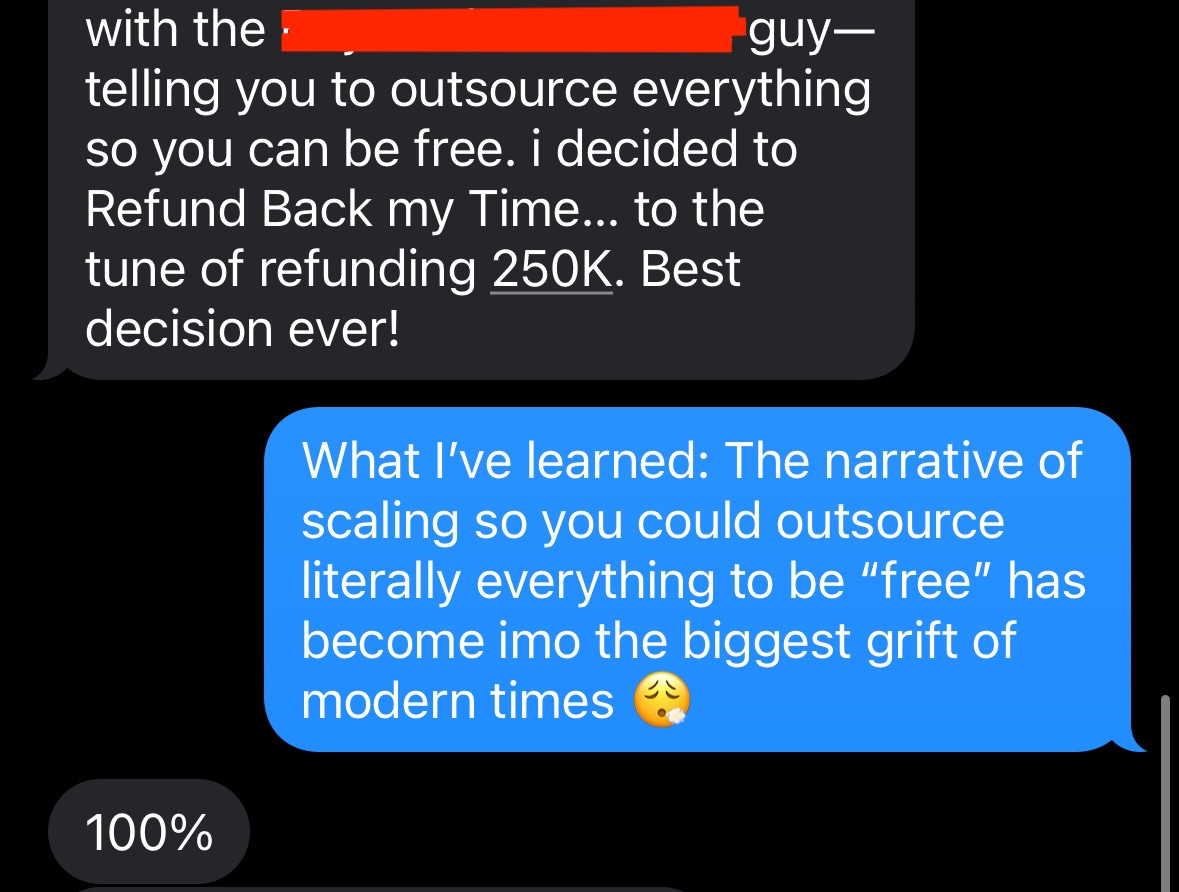

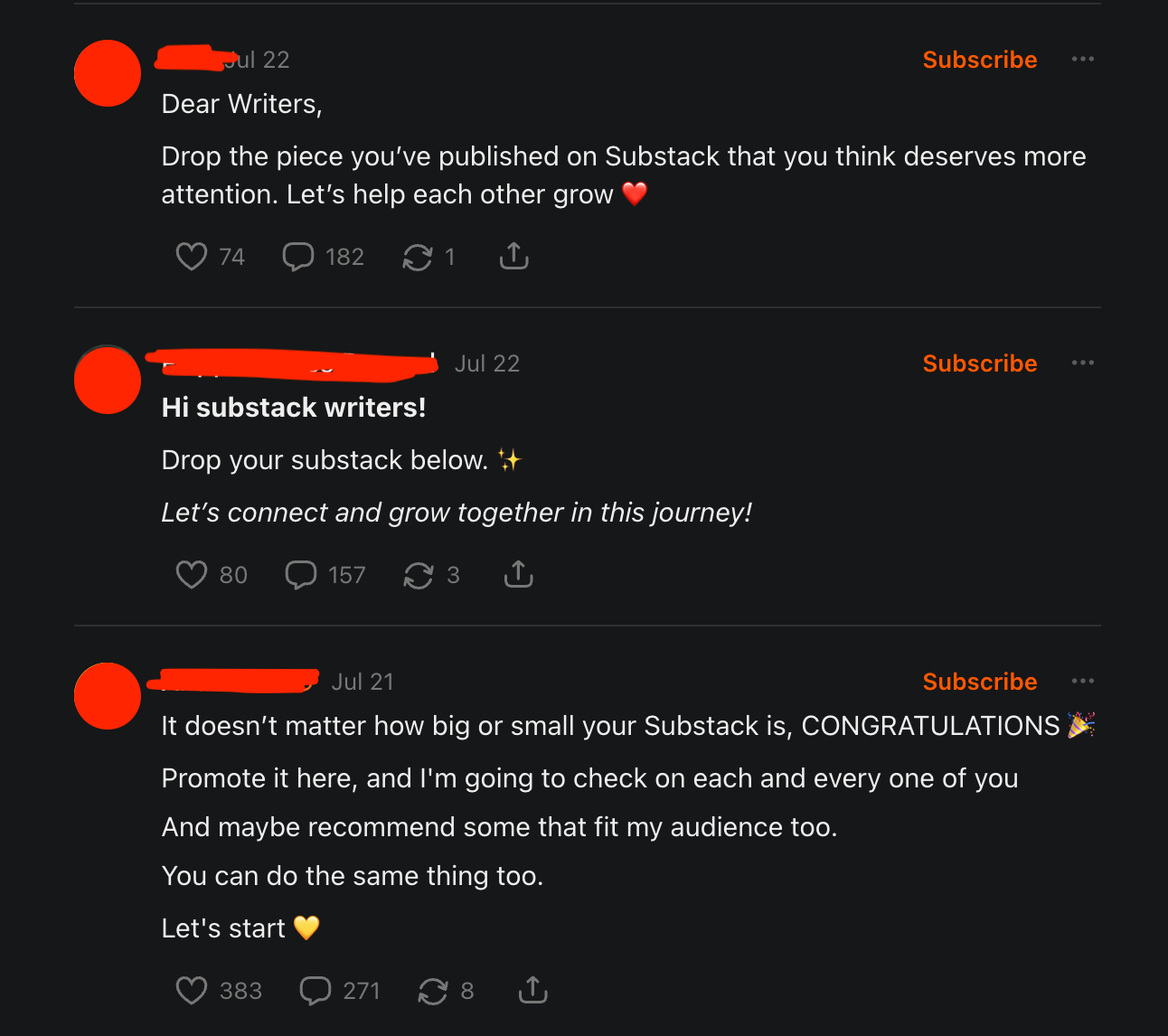
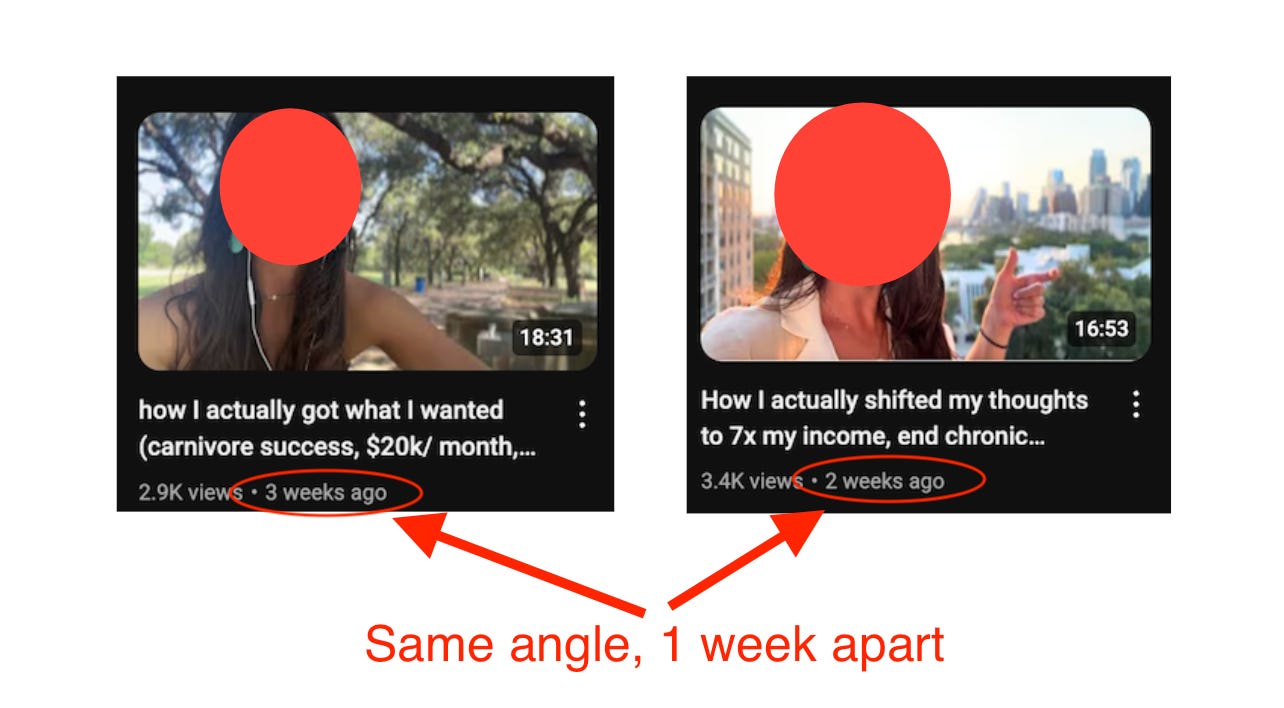



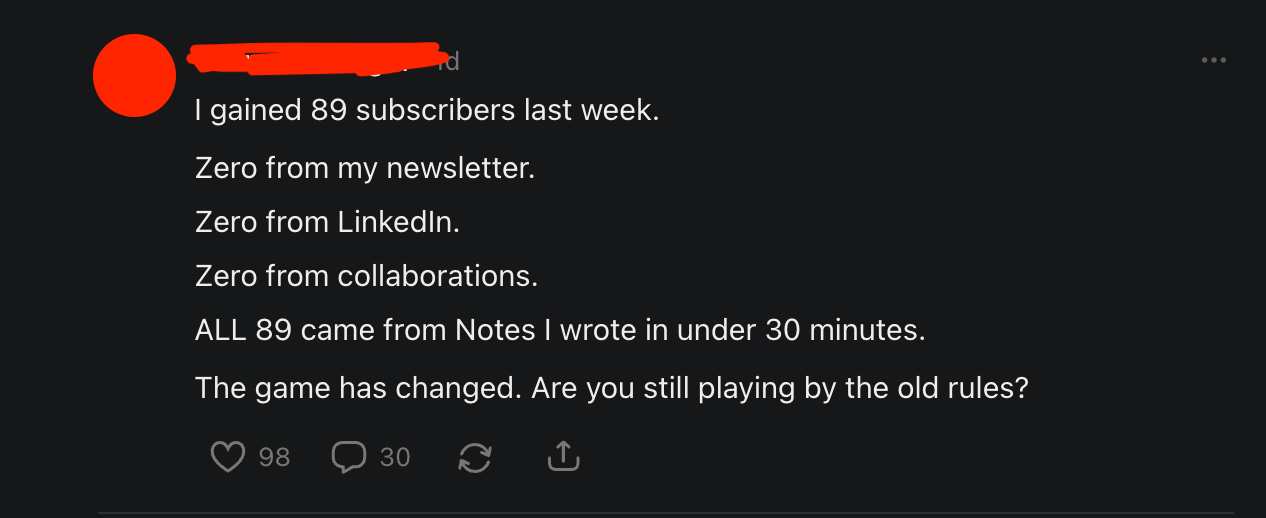


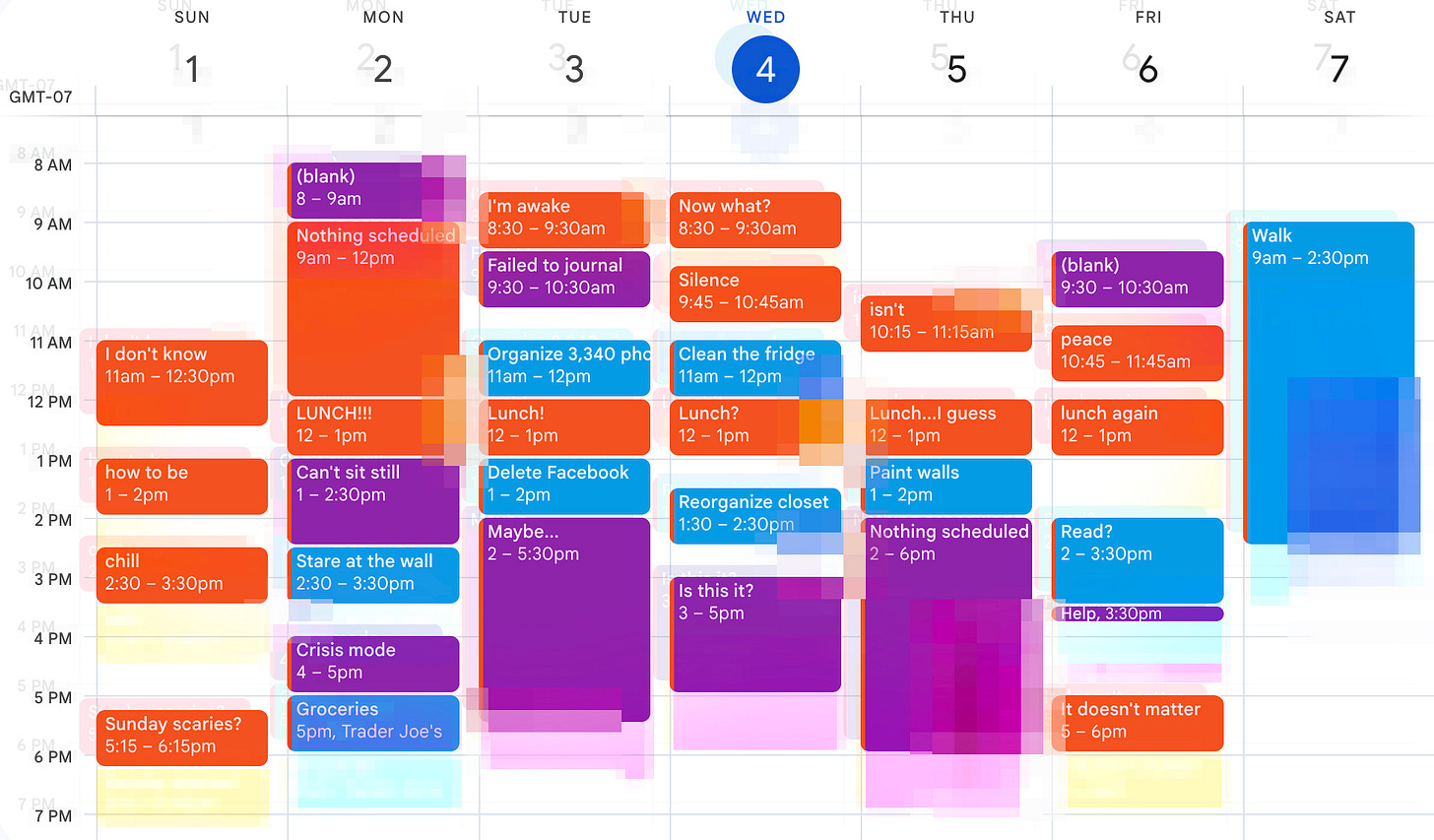


I’m genuinely tired of being sold shit at every corner of the internet. I wish I could just go back to making silly nonsense for my 5 friends on our geocities sites.